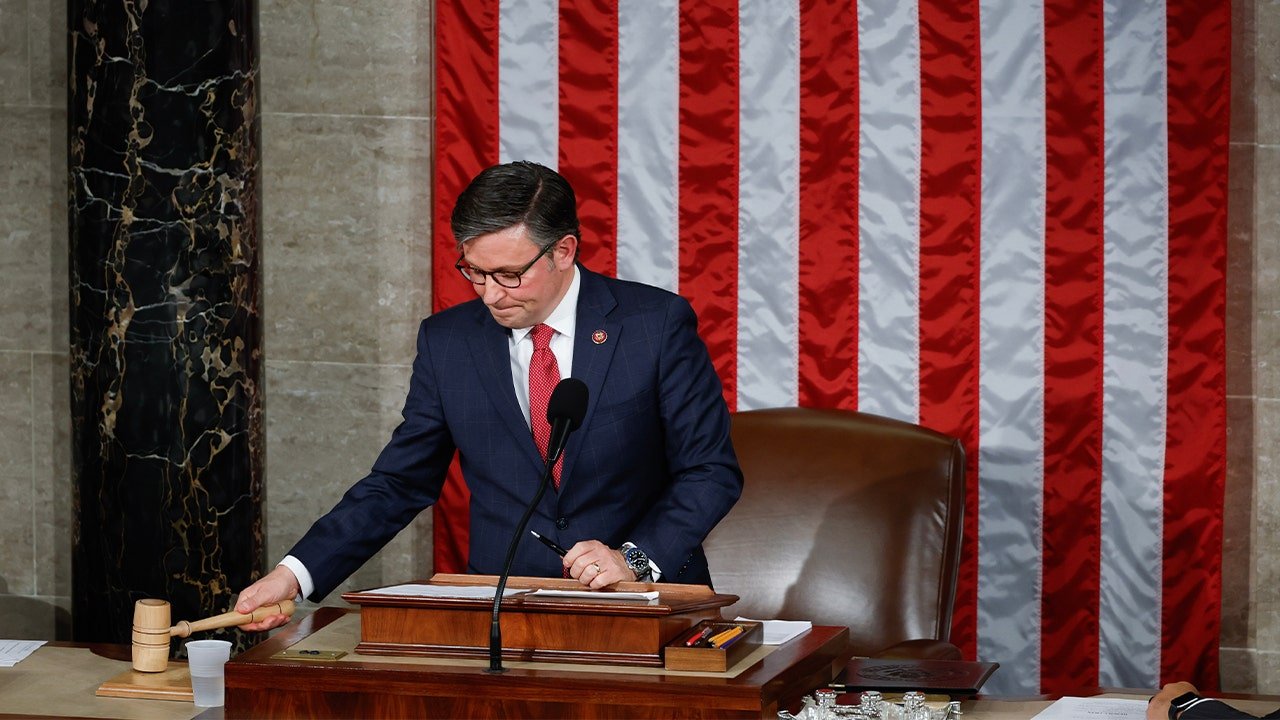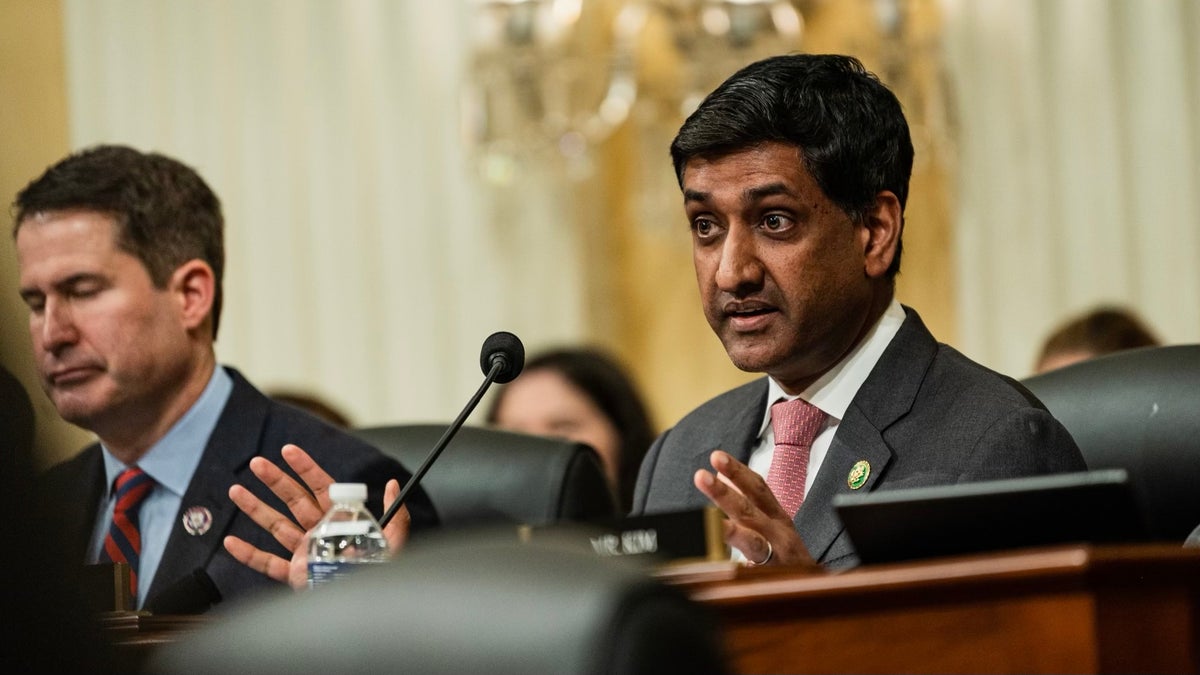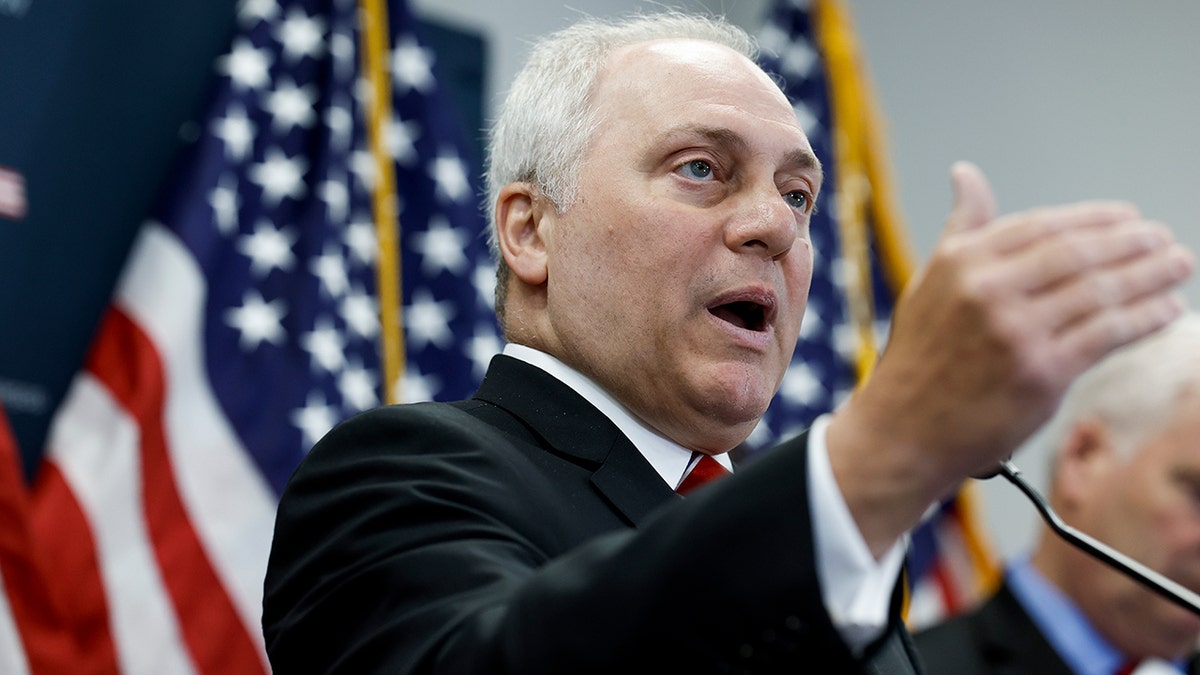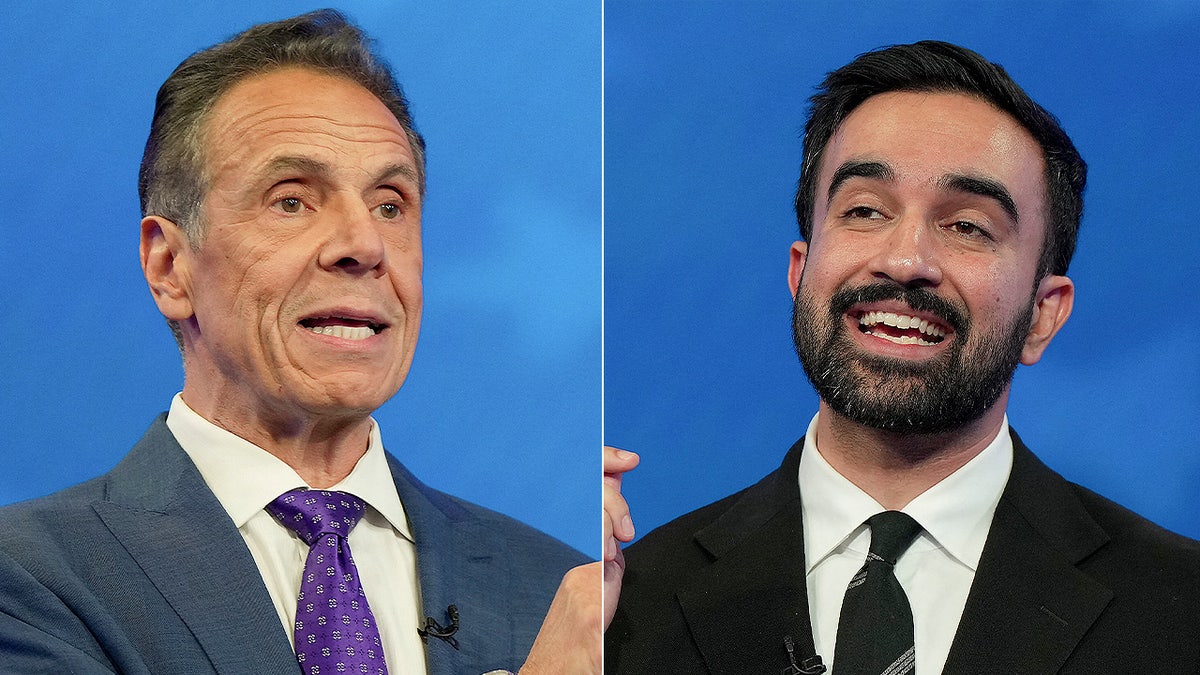INTERNACIONAL
Epstein files divide House Republicans in growing ‘summer of discontent’

NEWYou can now listen to Fox News articles!
William Shakespeare wrote about «the winter of our discontent» in Richard III. The line which follows that famous quotation suggests a grim winter morphed into a «glorious summer» and that «the clouds» are now «in the deep bosom of the ocean buried.»
Well, that «glorious summer» may have dissipated for House Republicans.
2025 is now the summer of discontent. The party is cleaved over the Epstein files.
Or, as the Bard might say, «To release or not to release. That is the question.»
‘CLEAR CORRUPTION’: JEFFRIES FACES COMPLAINT FOR PRESSING JUDGES TO OUST ALINA HABBA
The U.S. Capitol in Washington, D.C., seen on Wednesday, June 25, 2025. (Eric Lee/Bloomberg via Getty Images)
Many Republicans want the Epstein issue to disappear. But there’s a cohort of conservative House Republicans – well tapped into the MAGA base – who are apoplectic that the Trump administration hasn’t coughed up the files. That group of lawmakers represents a core component of the Trump coalition which prevailed last year. And it’s growing more disaffected by the day.
«I don’t think this issue is going away over August,» said Rep. Thomas Massie, R-Ky. «You don’t lose your base over one single thing. But [President Donald Trump] is eroding his base. More importantly, if we don’t take the right side of this issue, it’s going to cost us votes in the midterms. People are becoming despondent. They’re apathetic.»
Massie teamed several weeks ago with Rep. Ro Khanna, D-Calif., to compel the House to vote to demand the release of the files. But that measure doesn’t ripen until late this week. But if the House isn’t in session…
MARK GREEN RESIGNS FROM CONGRESS, FURTHER SHRINKING HOUSE GOP MAJORITY

Democratic Rep. Ro Khanna of California, right, speaks at a House committee hearing on Feb. 28, 2023, at the U.S. Capitol in Washington, D.C. (Office of Rep. Ro Khanna)
Democrats were more than happy to egg on the Epstein file effort – especially since some Republicans were upset with Johnson and how GOP leaders handled the issue.
«I’m not quite certain what his strategy is,» mused House Speaker Mike Johnson, R-La., about Massie. «I don’t understand Thomas Massie’s motivation. I really don’t know how his mind works.»
But House GOP leaders cut the House loose a day earlier than planned for the five-and-a-half week «August recess.» Johnson characterized August as «arguably the most important work month on our calendar» as Republicans try to meet with constituents and tout passage of the «big, beautiful bill.» Johnson called releasing the Epstein files running «roughshod.»
By Wednesday, Johnson gaggled with the congressional press corps to combat the narrative that the House was letting out early to avoid dealing with the Epstein issue.
«The published schedule of Congress was decided in December 2024. And it’s been published ever since. We are fulfilling the calendar,» said Johnson.

House Speaker Mike Johnson, R-La., said he doesn’t understand Thomas Massie’s motivations for pressing the Epstein issue. (Kent Nishimura/Getty Images)
But the House didn’t convene for votes as scheduled on Thursday. And even some Republicans weren’t buying Johnson’s argument.
«I guess we’re getting tired of these two-hour work weeks up here,» complained Rep. Tim Burchett, R-Tenn. «I’m sick of it. I came here to work.»
But the impasse over the Epstein files forced the House to scrap a bill by Rep. Stephanie Bice, R-Okla., to bolster penalties against persons who enter the U.S. illegally and are deported – and then try to come back. That’s one of the reasons the House cashed out Thursday from the schedule.
«I want to get some of these issues put to bed. Certainly the Epstein one seems to be the topic du jour. We’ve got to get past that,» said Bice. «We have to come to some sort of resolution. Sooner rather than later. We cannot let this drag on.»
But with the House done, that subject – which should be a layup for House Republicans – will remain in abeyance until after the recess.
Rep. Ralph Norman, R-S.C., didn’t mind the House cutting town early.

Rep. Ralph Norman, R-S.C., arrives for a meeting of House Republicans in the Capitol Visitor Center on the budget reconciliation bill on Thursday, May 15, 2025. (Tom Williams/CQ-Roll Call, Inc via Getty Images)
«We weren’t going to do that much this week anyway,» said Norman.
But he pointed out how Democrats were suddenly championing the Epstein issue because the mischief put Republicans in a fix and potentially caused headaches for Trump.
«The Democrats are trying to use this as a wedge issue This is the only thing they’ve got,» said Norman.
Massie said his resolution with Khanna would ripen for a vote when the House reconvenes in September. He suggested it would marinate under the hot, August sun.
«Dogs don’t bark at parked cars, right? This bill is moving. This is coming to a vote. We’ve got enough Republican co-sponsors of the bill. Twice as many as we need right now,» said Massie. «We’re going to force a vote on it. It’s not going away.»

Rep. Thomas Massie, R-Ky., arrives for the House Republican Conference caucus meeting in the Capitol on Wednesday, June 4, 2025. (Bill Clark/CQ-Roll Call, Inc via Getty Images)
In fact, as the House tried to take its last votes until September, Rep. Summer Lee, D-Penn., sprang a vote on the House Oversight Subcommittee on Federal Law Enforcement, requiring a subpoena of the Epstein files.
«I expect my Republican colleagues to care about this because their constituents certainly care about child sex trafficking, whether it’s through the immigration system like this hearing alleges, or by a U.S. citizen facilitating other powerful U.S. citizens. It’s time for them to prove it right now,» said Lee.
The Pennsylvania Democrat could read the room. Conservative Republicans interested in the Epstein files comprised the membership of the panel: Rep. Clay Higgins, R-La., is the subcommittee chairman. Reps. Lauren Boebert, R-Colo.; Paul Gosar, R-Ariz.; Brian Jack, R-Ga.; Nancy Mace, R-S.C.; Andy Biggs, R-Ariz.; and Scott Perry, R-Penn., made up the rest of the GOP roster.

Rep. Ralph Norman, R-S.C., said the Epstein files issue have become a «wedge issue» for Republicans. (AP Photo/J. Scott Applewhite)
The panel voted 8-2 to subpoena the Epstein files – but only after Perry amended Lee’s plan by simultaneously issuing subpoenas for former President Bill Clinton, former Secretary of State Hillary Clinton, former FBI Directors James Comey and Robert Mueller, along with former Attorneys General Loretta Lynch, Eric Holder, Merrick Garland, Bill Barr, Jeff Sessions, and Alberto Gonzales.
In short, this isn’t going away.
The House Appropriations Committee scheduled a «markup session» for Thursday to prepare the annual Commerce, Justice and Science spending bill for the floor. But leaders abruptly canceled that meeting Wednesday night. Some of it was due to «exhaustion,» as members have been lingering in Washington so long this summer. Some of it was because the House canceled votes. Appropriations Committee members didn’t want to be in Washington. But the other component was the threat of Epstein-related amendments.
So, they pulled the plug.
This came after both Johnson and House Majority Leader Steve Scalise, R-La., made a point of telling reporters that committees would still meet – even though the House canceled votes for the rest of the week.

House Majority Leader Rep. Steve Scalise, R-La., speaks to reporters at a press conference following a House Republican Conference meeting at the U.S. Capitol Building on July 18, 2023, in Washington, D.C. (Anna Moneymaker/Getty Images)
«We have nine or ten committees working through, markups this week. Many tomorrow,» said Johnson on Wednesday.
«We’re going to have committee meetings through Thursday. And there’s still a lot of work being done,» said Scalise. «Most members know that the work of Congress is mostly done in committee.»
But not this time.
Granted, the House Oversight Committee took closed-door testimony from former Biden administration Chief of Staff Ron Klain about President Joe Biden’s cognitive abilities. But that was about it for the House.
CLICK HERE TO GET THE FOX NEWS APP
«Today marks the first day of the House embarking on their Epstein recess,» declared Senate Minority Leader Chuck Schumer, D-N.Y. «And already the story Republicans hoped would quietly fade is growing louder by the hour.»
«It’s going to keep percolating,» predicted Khanna. «This is just breathing more life.»
August is often a news vacuum. And so something has to fill the void. The Epstein files could be it.
And that only fuels the summer of discontent.
INTERNACIONAL
Bruce Springsteen tiene su película película biográfica, pero no es la que se podía esperar

Durante meses del año pasado, Jeremy Allen White tuvo a Bruce Springsteen hablándole constantemente al oído.
White escuchó una y otra vez la narración en audio de 18 horas de las memorias de Springsteen, Born to Run, como parte de una intensa preparación para interpretarlo en la próxima película Springsteen: música de ninguna parte, que narra las dificultades del ícono del rock para crear su álbum Nebraska en 1982.
“Eso sonaba en casa todo el tiempo”, recordó White, conocido por ser el protagonista de la serie The Bear, en una reciente entrevista por video. “Cuando salía a correr, cuando caminaba, cuando preparaba la cena. Me ayudaba mucho tener su voz conmigo todo el tiempo”.
Springsteen: música de ninguna parte, escrita y dirigida por Scott Cooper (Crazy Heart), ofrece algunos momentos propios de la épica biográfica del rock, como un White empapado en sudor cantando “Born to Run” ante una multitud o improvisando para un público devoto en el club Stone Pony de la costa de Nueva Jersey.
Pero al centrarse en Nebraska —una galería de personajes frágiles en clave acústica— y el colapso depresivo que Springsteen atravesó tras su grabación, la película se convierte en una exploración sobre la fragilidad de la salud mental y los límites del arte como sostén vital. En una escena tomada directamente de las memorias del músico, el hombre generalmente visto como el ideal del rock entra en la consulta de un terapeuta y rompe a llorar en silencio.
El objetivo de Cooper, dijo, “nunca fue contar la historia completa de Bruce Springsteen”. “Me esforzaba por hacer algo más tranquilo y más interior, sobre este momento muy específico en la vida de Bruce”, añadió el director, “sobre un hombre que enfrenta algunos de los traumas que arrastra desde su infancia”.
Springsteen: música de ninguna parte marca la primera vez que “El jefe” permite que su historia sea dramatizada en una película, y no es casualidad que Nebraska sea el núcleo. Springsteen ha dicho que considera este álbum quizás el mejor, aunque siempre ha sido una rareza y un misterio en su obra.
Compuesto mientras comenzaba a trabajar las canciones que dos años después integrarían Born in the USA, Springsteen grabó Nebraska en solitario, con una grabadora simple de cuatro pistas, en una casa alquilada en Colts Neck, cerca de Freehold, en Nueva Jersey. El músico trabajó en ella durante los meses posteriores a la exitosa gira de The River, su primer álbum número uno, bajo la presión de sostener su popularidad.

Las grabaciones de temas como “Atlantic City”, “Johnny 99″ y “Nebraska” —relatos de crimen, soledad y personajes en busca de esperanza— fueron concebidas como maquetas a desarrollar junto a la E Street Band. Pero Springsteen quedó cautivado por el sonido crudo y fantasmal de las cintas, y tras intentos frustrados de rehacerlas en el estudio, decidió que la versión original saldría tal cual, a pesar de la escasa fidelidad. En la película, los productores lidian con la dificultad de convertir el casete en un master comercialmente viable.
Para la discográfica y su entorno, fue una decisión desconcertante y arriesgada para un artista en ascenso; una jugada que, bajo la mentalidad común de la industria, podía suponer un freno a su carrera. Springsteen incluso insistió en que Nebraska no fuese promocionado con sencillos, giras ni entrevistas.
Warren Zanes, músico y académico que conoció Nebraska siendo un adolescente en la banda Del Fuegos en los años 80, afirmó que, aunque ama el disco, siempre le costó entenderlo como cambio de rumbo:“Fue, para mí, uno de los mayores giros a la izquierda en la historia de la música popular”.
Tras leer la descripción de Nebraska en las memorias de Springsteen, seguida de un relato profundo de una crisis emocional, Zanes comenzó a escribir un libro sobre el álbum, entrevistando a Springsteen y a su mánager de toda la vida, Jon Landau. Ese libro, titulado Deliver Me From Nowhere (Líbrame de la nada, título original en inglés de la película también) se publicó en 2023 y Cooper lo utilizó como base para el guion.

La película retrata a Springsteen en este periodo como un personaje solitario y atribulado, pero productivo, inspirado en el filme Badlands (Malas tierras) de Terrence Malick (1973), el dúo punk Suicide y su propia biografía. Springsteen compone las canciones de Nebraska mientras revive recuerdos de infancia ligados a su padre, melancólico y bebedor, que aparece en un flashback en blanco y negro. Surge una relación con Faye, una madre soltera de Nueva Jersey, pero el músico no logra comprometerse con ella. (Faye, figura compuesta, es el único personaje principal que no está basado en una persona real).
“Bruce estaba obsesionado, no en lo gótico, sino en lo espiritual”, explicó Cooper, usando una gorra de Stone Pony. “Creo que lo obsesionaba su padre, emocionalmente distante, ese mito estadounidense de quienes persiguen el sueño americano y no lo logran”.
Cooper indicó que tanto él como Springsteen decidieron no construir una hagiografía, sino mostrar las luchas y fracasos del artista, además de sus logros. “No me interesaba mitificarlo”, declaró el director. “No estaba persiguiendo al Jefe. Busco al hombre solo en una habitación en Colts Neck con una grabadora tratando de darle sentido a su vida y a sus traumas”.
Las vivencias de Springsteen con la depresión, antes poco conocidas, se hicieron públicas en sus memorias de 2016. La relación con su padre ocupó un lugar central en Springsteen on Broadway, su espectáculo de 2017.

“Hace mucho tiempo, las defensas que construí para soportar el estrés de mi infancia, para salvar lo que tenía de mí mismo, dejaron de ser útiles”, escribió Springsteen en ese libro. “Me basé en ellas para aislarme, sellar mi alienación, aislarme de la vida, controlar a los demás y contener mis emociones hasta un punto perjudicial. Ahora el cobrador llama a la puerta, y su pago será en lágrimas”.
Cooper aseguró que White fue la única opción para el papel principal. “Pensaron que podía expresar una historia compleja con calma y mucha intensidad física”, dijo el protagonista.
El actor dudó. El papel exigía interpretación musical, pero White no era cantante ni había tocado guitarra. “Le dije: ‘Me gustaría hacer esto contigo, adoro a Bruce, ¿pero no prefieres a alguien que ya sepa hacerlo?’”.
Hasta que Cooper le transmitió que Springsteen mismo quería que lo interpretara. “En ese punto pensé: ‘No voy a interponerme en su camino’”.
Durante seis meses, White estudió guitarra y tomó clases diarias de canto con Eric Vetro, entrenador vocal de celebridades, responsable de la preparación de Austin Butler en Elvis y de Timothée Chalamet para Un completo desconocido.
En la película, la voz de White se escucha cuando canta en pantalla; en otras escenas es la voz de Springsteen.

Se ve a White con cabello desordenado, hombros musculosos encorvados en una campera de cuero negro, conduciendo un Camaro Z28 por las carreteras de Nueva Jersey, una imagen del Jefe de unos 30 años que sorprendió a sus compañeros de elenco.
“Se concentró por completo”, dijo Odessa Young, quien encarna a Faye. “Está muy presente y concentrado, y verlo interpretar a Bruce resultó casi inquietante”.
Gran parte del filme gira en torno a la relación casi fraternal de Springsteen con Landau, inicialmente crítico musical que luego se convirtió en su mánager y productor. Su colaboración histórica, desde 1975, es una de las más largas y exitosas del rock.
Jeremy Strong (Succession, El Aprendiz) interpreta a Landau como un artista empático y pragmático. Al oír Nebraska por primera vez, el representante intenta comprender la música y el dolor de su cliente. “Tiene una sensibilidad magistral”, señaló Strong sobre Landau.
Pero Landau sabe que hay un límite a su ayuda. En un momento crucial, Springsteen llega a una casa vacía en Los Ángeles y llama a Landau, quien le dice: “Necesitas ayuda, ayuda profesional”. El músico inicia terapia, a la que atribuye un cambio vital.
Persisten ciertas tensiones, sobre todo con la presión de la discográfica CBS respecto al lanzamiento de Nebraska. Finalmente, Landau y Springsteen salieron fortalecidos. Nebraska alcanzó el número 3 y fue celebrada por la crítica. Su álbum siguiente, Born in the USA, consagró a Bruce Springsteen como superestrella mundial.

Cooper optó por no dramatizar la negociación con CBS, evitando el cliché del conflicto entre artista y sello discográfico y enfocándose en la relación entre Springsteen y Landau. “Es una historia de amor entre estos dos hombres”, afirmó.
“La experiencia de Jon en la película pone a prueba su fe y determinación respecto a la visión de Bruce”, opinó Strong. “Aparecen imperativos comerciales versus imperativos artísticos y espirituales. En la vida real, Jon Landau jamás hubiera elegido lo primero”.
Springsteen y Landau aprobaron la realización de la película y Cooper dijo que ninguno de los dos pidió cambios. “Dejamos claro que era su historia”, afirmó Landau. “No solicitamos ni recibimos control sobre la filmación, el guion, la edición, el reparto, la música ni otro aspecto”. Agregó: “A mi juicio, es una de las mejores decisiones que hemos tomado”.
El rodaje comenzó en septiembre de 2024 y siguió hasta enero de 2025, mientras Springsteen realizaba su última gira. Él y Landau fueron presencias habituales en el set. “Casi todas las noches”, contó White, “recibía mensajes de texto de Bruce acerca de algún momento del rodaje que él sentía fiel a las emociones que vivió de joven”.
“Esos mensajes”, añadió, “me marcaron”.
Fuente: The New York Times
[Fotos: prensa The Walt Disney Company]
20th century studios,jeremy strrong,jon landau,springsteen: deliver me from no
INTERNACIONAL
Sparks fly as Cuomo, Mamdani tear into each other during fiery debate: ‘Toxic energy’

NEWYou can now listen to Fox News articles!
Front-runners for New York City mayor, Zohran Mamdani and Andrew Cuomo, wasted little time attacking each other on alleged personal scandals they have been involved in during a Wednesday night debate between the pair and GOP candidate Curtis Sliwa.
Mamdani and Sliwa took the opportunity during Wednesday’s debate to drill down on past sexual harassment allegations against Cuomo, the former governor of New York, ahead of an impeachment inquiry that preceded Cuomo’s 2021 resignation. Cuomo was also hit by Mamdani over accusations he has – while in public office – failed to meet with Muslim constituents and only began doing so amid pressure from his mayoral campaign, and over his alleged poor handling of the COVID-19 virus in New York after Cuomo was party to issuing guidance forcing nursing homes and long-term care facilities to admit COVID-19 positive patients.
Meanwhile, Cuomo did not hold back on targeting Mamdani over alleged controversies that have embattled his campaign. Cuomo blasted the self-proclaimed socialist over his lack of experience, ties to radical politics, and past radical comments about law enforcement, Israel and the situation in Gaza.
FBI AGENTS FROM ’93 WTC ATTACK BLAST MAMDANI FOR EMBRACING RADICAL IMAM
All three candidates for NEw York City governor debated Wednesday night. From left to right: Andrew Cuomo, Curtis Sliwa and Zohran Mamdani. (Photo by Angelina Katsanis-Pool/Getty Images)
«My main opponent has no new ideas. He has no new plan. … He’s never run anything, managed anything. He’s never had a real job,» Cuomo said of Mamdani during the debate. Cuomo also branded Mamdani as someone who has proven to be «a divisive force in New York,» pointing to past incidents that have garnered Mamdani heat from critics.
One of those incidents included a picture he took with a hard-lined Ugandan lawmaker who has pushed policies of imprisoning people for being gay, which Mamdani took while taking a break from the campaign trail to visit his home country of Uganda for a wedding. Cuomo also hit the controversy over whether Mamdani supports Jewish New Yorkers, as his critics have claimed he is anti-Israel pointing to statements he has made, like «globalize the intifada.»
Cuomo also accused Mamdani of disrespecting Italian-Americans after a video of him surfaced giving the middle finger to a statue of Christopher Columbus, while also pointing to criticism the self-proclaimed socialist candidate has garnered from 9/11 first-responders after posting a photo with a Muslim cleric who served as a character witness for the mastermind behind the September 11, 2001 attacks.
TOP 5 MOMENTS FROM FIERY NYC MAYORAL DEBATE: ‘HE LITERALLY HAS NEVER HAD A JOB’

Former New York Governor Andrew Cuomo (left) shakes hands on the debate stage with Democratic Party candidate for New York City mayor (right) Zohran Mamdani. Cuomo is running as an Independent after lsoing to Mamdani in the primary election. (Photographer: Angelina Katsanis/AP)
«You have been a divisive force in New York, and I believe that’s toxic energy for New York. It’s with the Jewish community. It’s with the Italian-American community – when you give the Columbus statue the finger. It’s with the Sunni Muslims when you say decriminalize prostitution, which is Haram. It’s the Hindus,» Cuomo continued. «Then, you take a picture with Rebecca Kadaga, deputy Prime Minister of Uganda. … She’s known as Rebecca ‘Gay Killer.’ … You’re a citizen of Uganda. You took the picture. You said you didn’t know who she was. It turns out you did. How do you not renounce your citizenship or demand BDS against Uganda for imprisoning people who are gay just by their sexual orientation? Isn’t that a basic violation of human rights?»
Mamdani shot back that his politics have remained «consistent» and that they are built on a belief in human rights for all people, including LGBTQ+ folks. Had he known Kadga’s role in drafting legislation to imprison gay folks, Mamdani said, he never would have taken the picture.
«This constant attempt to smear and slander me is an attempt to also distract from the fact that, unlike myself, you do not actually have a platform or a set of policies,» Mamdani shot back at Cuomo before introducing his own claims about the former governor regarding past accusations of sexual harassment.
MAMDANI RIPPED BY RIVALS FOR UNPOPULAR STANCE DURING FIERY NYC DEBATE: ‘YOU WON’T SUPPORT ISRAEL’

New York City mayoral candidate Andrew Cuomo slammed his democratic socialist opponent Zohran Mamdani during Wednesday’s debate for a variety of alleged scandals he has been involved in. (Angelina Katsanis/Getty; Angelina Katsanis/Getty)
«Mr. Cuomo. In 2021, 13 different women who worked in your administration credibly accused you of sexual harassment. Since then, you have spent more than $20 million in taxpayer funds to defend yourself, all while describing these allegations as entirely political,» Mamdani said while attacking Cuomo Wednesday night.
«You have even gone so far as to legally go after these women. One of those women, Charlotte Bennett, is here in the audience this evening. You sought to access her private gynecological records. She cannot speak up for herself because you lodged a defamation case against her. I, however, can speak. What do you say to the 13 women that you sexually harassed?»
Cuomo, in 2021, was accused of multiple incidents of sexual harassment that preceded his resignation as governor that year. A subsequent report from New York Attorney General Letitia James confirmed Cuomo «sexually harassed multiple women from 2013 through 2020,» while in January 2024, the U.S. Department of Justice announced it had reached a nearly $500,000 settlement with Cuomo’s executive office over one of the claims. However, no criminal charges were ever filed against Cuomo, with some district attorneys citing insufficient evidence.
CLICK HERE TO GET THE FOX NEWS APP
Cuomo defended himself against Mamdani’s accusations, noting the cases were eventually dropped, before returning to questions about Mamdani’s alleged past.
Meanwhile, Sliwa didn’t skip an opportunity to slam Cuomo over the sexual assault allegations either, saying early in the debate during a discussion about homelessness that Cuomo «fled» the governor’s office amid an impeachment inquiry that was investigating him.
«Andrew, you didn’t ‘leave.’ You fled from being impeached by the Democrats in the state legislature,» Sliwa began before getting into the homelessness issue, earning him a round-of-applause from the audience.
«‘Leave?’ You fled!» Sliwa continued to applause. «But let’s get back on topic.»
elections state and local,2025 2026 elections coverage,andrew cuomo,zohran mamdani,nyc mayoral elections coverage
INTERNACIONAL
Ahora la Justicia de Chile investigará el caso de Bernarda Vera, la desaparecida que encontraron viviendo en Argentina

Tres semanas después del revuelo político generado en Chile por el presunto hallazgo en Argentina de Bernarda Vera, una mujer que integraba el listado oficial de víctimas de la dictadura militar de Augusto Pinochet, la Justicia chilena abrió una investigación para dar con su paradero.
La causa fue radicada el Primer Juzgado del Crimen de Temuco, en la región de La Araucanía, y quedó bajo secreto de sumario. El caso lo lleva adelante el ministro de la Corte Álvaro Mesa, especialista en causas de violaciones de los derechos humanos.
Video
Así fue el encuentro entre las cámaras de TV y la mujer que podría ser Bernarda Vera
A través de un escrito, el funcionario afirmó que «hasta hace pocos meses no existían causas vigentes respecto a los delitos de desaparición forzada, secuestro o detención ilegal de Bernarda Vera Contardo«, nombre que figura entre las 1.162 personas incluidas en el Informe de la Comisión Verdad y Reconciliación (Rettig).
El panorama cambió, según el portal Bio Bio Chile, ante el surgimiento de algunas «incongruencias en los relato» que fueron reportadas por el Plan Nacional de Búsqueda (PNB) del Programa de Derechos Humanos» y derivaron en la apertura de «un cuaderno de búsqueda».
La protagonista de la historia es Bernarda Vera, una profesora que, con 27 años y una hija de 5, fue detenida por militares el 10 de octubre de 1973 y que, aparentemente, había sido ejecutada en el puente de Villarrica, también en la región de La Araucania. Sin embargo, el caso dio un giro a fines de septiembre cuando salió a la luz una investigación periodística que habría ubicado a quien fuera militante del Movimiento de Izquierda Revolucionaria (MIR) en la localidad bonaerense de Miramar.
Desde el gobierno de Gabriel Boric fue el ministro de Seguridad, Luis Cordero, quien señaló que la tarea de «corroborar científicamente la identidad de la mujer que vive en Argentina y que sería Bernarda Vera» le corresponde efectivamente al juez que tramita la causa.
La consulta al funcionario se debe a que fue quien estaba al frente del Ministerio de Justicia y Derechos Humanos cuando se puso en marcha el Plan Nacional de Búsqueda, Verdad y Justicia y es el señalado por la oposición como el responsable de la eventual «inexactitud respecto al caso».
Conocida como «Anita» en sus tiempos de militancia en el MIR, Bernarda Vera figura en el Informe Rettig, el registro de las víctimas de violaciones a los derechos humanos durante la dictadura pinochetista. Testimonios que quedaron fuera de la causa y algunos detalles del boletín que cada mes publica el PNB dieron indicios de que la mujer podría haber escapado de ese destino.
El reporte que se difundió en septiembre mencionó que «en algunos casos, muy excepcionales, este proceso ha revelado incongruencias con las conclusiones de las Comisiones de Verdad. Un primer caso refiere a una persona, condenada a muerte por un Consejo de Guerra en 1973, que fue calificada por la CNVR (Comisión Rettig), con los antecedentes disponibles en la época como víctima de desaparición forzada”.
Video
El momento en el que un informe de TV encontró a Bernarda Vera, la supuesta desaparecida chilena que vive en Argentina
“Posteriormente, el PNB recogió testimonios de personas que dijeron haberla visto fuera de Chile después de la fecha en la que la CNVR estableció su desaparición. A raíz de ello, se abrió una investigación administrativa respecto de su trayectoria. Estos antecedentes fueron puestos en conocimiento del Comité de Seguimiento y Participación del Plan Nacional de Búsqueda; de la familia de manera reservada para proteger su privacidad; y al mismo tiempo, se ofició oportunamente al Ministro en Visita Extraordinaria con competencia en la causa”, detalla el documento.
Esos datos fueron parte de la investigación periodística de Chilevisión, que condujo a una de sus cronistas a la ciudad de la costa bonaerense y donde habría dado con el paradero de Bernarda Vera Contardo, quien detrás de la puerta de su casa se negó a hablar con la periodista. El tema generó un fuerte debate en el país y desató fuertes críticas a la administración del Frente Amplio.

 CHIMENTOS3 días ago
CHIMENTOS3 días agoPampita recibió un video inesperado de su hija Blanca en el Día de la Madre y no pudo contener la emoción

 POLITICA3 días ago
POLITICA3 días agoDonald Trump habló sobre la ayuda económica de Estados Unidos: “La Argentina está peleando por su vida”

 DEPORTE15 horas ago
DEPORTE15 horas agoUniversidad de Chile vs. Lanús, por la Copa Sudamericana: día, horario y cómo verlo por TV















